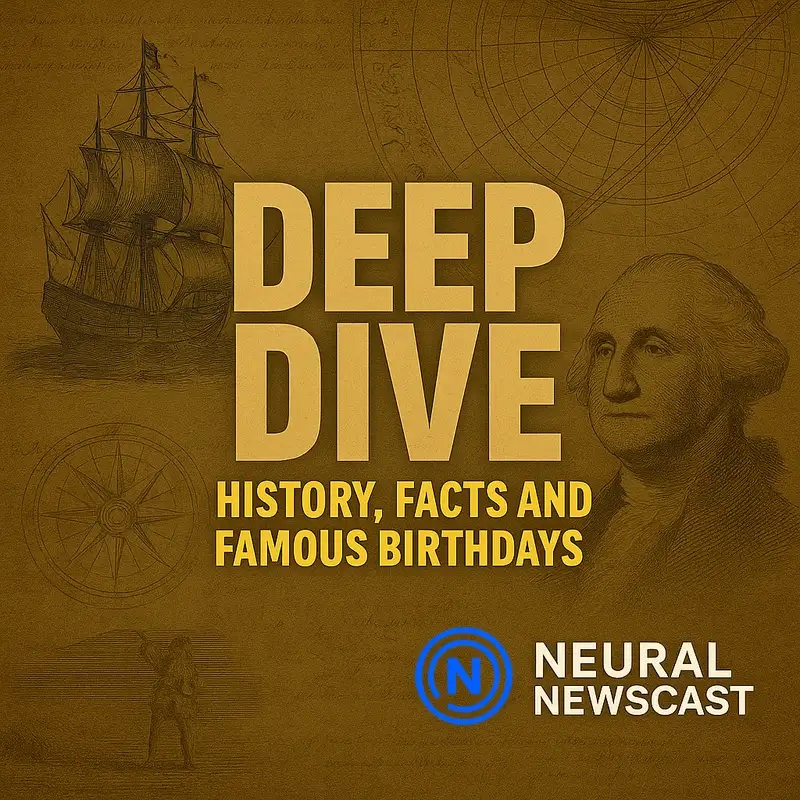Deep Dive: Anne Boleyn's Fall, A Star Is Born, and The Rise of Superwood - May 19, 2025
This is NNC, Neural Newscast.
All the day's news and information you need to know starts now.
Get ready for a deep dive from Neural Newscast.
I'm Thomas, and Daniel is here with me as we delve into today's subjects.
So Daniel, get this, on this very day in 1536,
and Boulin met her tragic end,
executed on charges that, to be honest, have always sparked a lot of debate.
Right, Thomas.
I mean, and Bullen's story is like the ultimate Tudor drama, isn't it?
You've got love, power, betrayal, and a fair share of political intrigue.
It's Shakespearean, but, you know, 100% real life.
And what's wild is that her rise and fall were so meteoric.
She was basically the catalyst for Henry the 8th break from the Catholic Church,
and then in just three years of marriage,
she goes from Queen to, well, the scaffold.
It's fascinating how quickly things spiraled.
I think what's often overlooked is how intelligent and politically savvy and was.
She wasn't just some pawn in Henry's game.
She played her own cards, too, which, ironically, might have been her downfall.
Exactly, Daniel.
She had this incredible influence over Henry and through him English politics,
but that influence made her enemies at court.
It's almost like she was caught in a web of her own making and others.
And let's not forget the fact that she couldn't produce a male heir.
That was a huge deal back then.
Henry was desperate for a son, and after Elizabeth was born, there was just nothing.
It's sad to think that failing to have a son could lead to such drastic consequences, right?
And the charges against her, treason, adultery, and incest were so extreme.
Many historians today argue that they were trumped up, essentially fabricated to get her out of the way.
But what's your take on that?
I'm with the skeptics.
It seems like it was more about politics and less about actual wrongdoing.
It was Henry's way of clearing the path for Jane Seymour.
And that whole trial?
I mean, the outcomes were probably decided before it even started.
Anne's trial really was a spectacle.
You had these so-called confessions extracted under duress, and the jury, composed of people
who owed their positions to Henry, talk about a stacked deck.
Totally. And her execution was the first of its kind in English history.
A French swordsman was brought in, supposedly to make the beheading more humane.
It's chilling to think that even in executing her, they were concerned with appearances and politics.
I think Anne knew the role she played in history.
On the scaffold, she reportedly said she was prepared to die and was not blaming anyone.
It's as if she accepted her fate as part of the greater game of thrones that was playing out around her.
And her legacy? It's enormous.
She gave birth to Elizabeth I, one of England's greatest monarchs,
who ironically would reign longer than any of Henry's sons.
And story didn't end with her death. It echoed through history.
Precisely, Daniel, and Bolin might have been executed on this day, but her impact,
That's something that's still very much alive in history today.
Today we celebrate the birthdays of Samuel Morse 1791,
Emily Post 1872, and Bjork, 1965.
Oh, Bjork, she's amazing, but you know what?
I think we should dive into Samuel Morse.
His story is just fascinating.
Absolutely, Samuel Morse is often only remembered for the Morse code, but did you know
he was also an accomplished painter before diving into the world of telegraphy?
That's right.
He actually studied art in England and was quite well regarded.
He painted portraits of some pretty influential people, including President John Adams.
Exactly, and it wasn't just a hobby either.
He poured his heart into it until tragedy struck.
It was during a painting trip that he received a letter about his wife's sudden illness and death,
which he learned about far too late due to the slow communication methods of the time.
That event really changed the course of his life,
pushing him towards the invention of the telegraph.
His personal loss fueled his drive to improve communication.
Talk about turning grief into innovation.
Thank you.
He teamed up with Alfred Vale and together they created the Morse Code System,
a revolutionary breakthrough that changed the world.
Can you imagine how different history would be if messages still took days, weeks, or even months to deliver?
Morse's invention was the early seed of our modern communication network.
And even more impressive, he initially faced a lot of skepticism.
People thought the idea of sending messages over wires was as believable as time travel.
It's a testament to his resilience.
Despite skeptics and financial challenges,
Morse persevered and eventually saw his vision come to life.
The first message sent was,
What hath God wrought?
A fitting phrase for the dawn of a new era.
Now, his legacy is everywhere.
The Morse code isn't just for telegraphy anymore.
It's used in aviation, radio communications,
and even as a learning tool for the visually impaired.
It's so interesting that one man's passion and persistence could ripple across centuries,
touching everything from how we write today to the digital landscape we navigate daily.
Samuel Morse's legacy reminds us that innovation often begins with a personal story,
one of loss and the determination to ensure no one else has to experience such a delay in receiving crucial news.
Yeah, and that's the beauty of it.
A simple desire to improve communication has left a lasting imprint on our world,
showing how interconnected we all are.
Indeed, the lasting relevance of Morse's work is a testament to how far reaching the impact of innovation can be
when paired with a fierce personal conviction.
Stay with us more deep dive exploring coming up.
You are listening to NNC, Neural Newscast.
Subscribe and listen wherever you choose,
and be sure to listen to our archive for more content like this episode,
publish daily at nNewscast.com.
And we're back with more from Neural Newscast Deepdive.
Did you know there's a startup in Maryland
that's invented something called Superwood?
It's supposedly tougher than metal.
Really? Superwood?
That sounds like something out of a comic book.
What exactly makes it so super?
It's all about the process.
They take ordinary wood and put it through this intensive treatment where it's compressed
and then boiled in a chemical bath.
It densifies the fibers to make it stronger and more durable than steel.
Wow, that's nuts.
So what's the point?
Are they going to start building skyscrapers out of trees now?
That's the dream.
It's not just about strength.
Superwood is also much lighter and more sustainable than metal.
Imagine reducing the carbon footprint of construction projects by using what's essentially transformed the lumber.
I love that.
Use more wood cut down less steel.
It's like hitting a sustainability jackpot.
But how do they ensure it doesn't rot or get eaten by termites?
Good question.
In the treatment, the wood becomes resistant to both rot and pests.
Plus, it's incredibly water resistant due to the way the wood is compressed, squeezing
out all the empty space that would normally absorb moisture.
That's brilliant. But what about cost?
Is super wood going to be affordable for broad use?
Or is this another luxury material?
Right now, it's still in experimental phases, so the cost is higher than regular lumber.
But once they ramp up production and refine the process, they aim to make it competitive with traditional building materials.
It could be a game changer if it becomes cost effective.
I can see a future where architects are going wild with super wood.
Imagine these sleek, modern designs made entirely out of wood that doesn't look like wood at all.
Exactly, and not just buildings.
They're even eyeing industries like automotive and aerospace.
Lighter and stronger materials are a huge advantage there.
Think about it, cars with wooden panels that are tougher than steel,
That would be such a throwback to those old wood-paneled station wagons,
but with a futuristic spin, I'd love to see how it impacts design aesthetics.
Totally.
Superwood could redefine how we think about materials and engineering and design,
blending form, function, and sustainability.
It's like the trifecta of innovation.
Right?
And every time you see something made with it, you'd have to remind yourself that's wood.
That's super wood.
It's a fascinating development.
I can't wait to see how it evolves and hits the market.
Whether it's our homes, our vehicles, or even our furniture, superwood could be the hero
material of the 21st century.
Here's to hoping Superwood gets all the limelight it deserves and transforms the way we build our future.
Thanks for tuning into our deep dive.
I'm Daniel, and from Thomas and the Neural Newscast team, we'll see you next time.
You have been listening to NNC.
Visit NNewscast.com for more episodes and deep dives.
Neural Newscast blends real and AI-generated voices for fast, high-quality production.
All content is AI generated with human oversight, including fact-checking and review.
While we aim for accuracy and neutrality, errors may occur.
Verify critical details from trusted sources.
Learn more at NNewscast.com.

